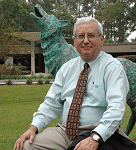Surviving Math, Surviving College
According to a 2000 community college study by Miami Dade College (FL) President Emeritus Robert McCabe, 41 percent of students entering community colleges are underprepared in at least one basic skill area.
- By Dian Schaffhauser
- 12/01/09
A three-year study of community
college students, published in 2009
by the National Center for Education
Statistics, reported that 41 percent of community
college students who were "not
directed" toward college completion
dropped out during their first year. The
fact that the percentages in the two studies
are the same is a coincidence. What is not
a coincidence is that unprepared and
undirected students are the most at-risk for
not graduating; bringing those students up
to readiness in basic skills and putting
them on a path toward graduation can
mean the difference between retaining and
losing their enrollment. Technology can
offer community colleges a way to target
learning support to students who most
need it, when they need it. Here's one
Florida school's story about addressing
the toughest benchmark of all: meeting
math graduation requirements.
 Lake City Community College VP of Instruction and Student Services Charlie Carroll
Lake City Community College VP of Instruction and Student Services Charlie Carroll
ENROLLMENT AT LAKE CITY COMMUNITY COLLEGE is up 20 percent from last year, according
to Charlie Carroll, vice president of instruction and student services for the 7,000-student college in northern Florida.
But that increase is nearly nullified by the college's retention numbers. Of those new students classified as "not college ready"--
nearly two-thirds of new enrollments at Lake City who need at least one developmental course in reading, writing,
or math-- only six out of 10 will return for a second semester. That retention rate drops to four out of 10 as students
move into their second year. For college-ready students the numbers are better; 65 percent come back in year two.
Yet overall, by the beginning of year two, only 52 out of every 100 students in that previous year's cohort are still taking
classes at Lake City. A 20 percent enrollment increase won't come close to covering the loss.
That dismal record troubles Carroll. "As somebody wiser than I once said, it is easier to retain than to recruit," he says. "If
we could keep 60 percent between years one and two instead of losing 60 percent, then our enrollment is going to stay up."
Seeking to catch hold of and redirect its students, the college introduced a successful mandate wherein students must declare
a major by the time they've accrued 15 credit hours-- about a semester's worth of classes. Students are unable to register for additional courses until that's been done.
"We're getting them focused on a target
to work toward," Carroll says.
In addition, the college now has faculty
contact students who miss a class
within the first two weeks. When a student
misses more than one class, the
institution sends out a formal notification
and student advisers do follow-up.
Longer-term measures include bolstering
professional development for faculty
to improve their discourse methods and
better engage students; providing funding
to students dealing with life issues
that make attendance at college difficult;
and adding a teacher-in-residence program
specifically to support those students
identified as not college-ready.
Lake City has found that eight live
tutors in the learning lab is not
nearly enough to meet demand.
Students need something they can
go to immediately for math help.
Still, none of these efforts alleviates
the biggest pain point for the majority of
students: making it through math. Of all
graduation requirements, math is the
line in the sand. As Steve Robbins, vice
president of research at ACT, Inc.
described the dilemma in a March 2009
Innovators conference presentation on
effective community college enrollment
management, "If you don't ‘survive'
math, you don't survive college."
The Math Hurdle
Like most two-year institutions, Lake
City has an open-door policy in which it
will enroll any applicant who has completed
high school, regardless of academic
record. That means, explains
Carroll, that "a lot of those students
haven't completed a higher-level math
course in high school." Florida state law
stipulates that every student has to pass
two college-level math classes to get an
associate of arts degree, and Lake City
has done studies which show that "there
is a significant relationship between the
grade achieved in MAT0024 [algebra 1]
and successful completion of MAT1033
[algebra 2]." Students who achieve A's
and B's in that first class are more
likely to complete the second algebra
course, and thus go on to graduate.
Walking the Talk
 "TECHNOLOGY CAN HAVE tremendous
potential for a positive impact on retention
and graduation rates. But speaking
first in terms of technology-supported
courses, there is one caveat: To achieve
the initiative's goals, any courses that will
be built must be designed around the
core that students need to graduate, not
what people simply want to produce. I
look back at the national telecourse
model that grew up out of funds provided
by Walter Annenberg, and a lot of the
courses that were picked were based on
agendas other than helping students
reach graduation.
So you had topics
that were not in the
core, taking the
focus off the real
mission of the funding.
It's also important
to consider a
plan to keep courses
current over time. If they are just left for
everyone to adapt, modify, fix, or update at
will, the courses will probably become so
outdated that we lose them altogether."
"TECHNOLOGY CAN HAVE tremendous
potential for a positive impact on retention
and graduation rates. But speaking
first in terms of technology-supported
courses, there is one caveat: To achieve
the initiative's goals, any courses that will
be built must be designed around the
core that students need to graduate, not
what people simply want to produce. I
look back at the national telecourse
model that grew up out of funds provided
by Walter Annenberg, and a lot of the
courses that were picked were based on
agendas other than helping students
reach graduation.
So you had topics
that were not in the
core, taking the
focus off the real
mission of the funding.
It's also important
to consider a
plan to keep courses
current over time. If they are just left for
everyone to adapt, modify, fix, or update at
will, the courses will probably become so
outdated that we lose them altogether."
-- Steven Sachs, vice president, instructional
and information technology, Northern Virginia Community College
To ensure students successfully get
past the math graduation hurdle, the college
has set a requirement that all students
in remedial classes have to spend
an additional hour per week participating
in a college wide learning lab. That
lab provides human tutors, an occasional
video conference with tutors from
other Lake City campuses, as well as
computers accessing tutoring software
like MyMathLab (a supplement to Prentice
Hall textbooks) and MathTV.com.
But like many community colleges,
Lake City serves students across a wide
geographic area-- in this case, five
counties. Students, especially those
enrolled in distance learning classes,
aren't necessarily able to get to the lab in
person. To help those students, the college
also contracted with Smarthinking,
an online service that connects students
to master's degree- certified tutors on a
24/7 basis.
As Carroll explains, students link to
the service through the campus Blackboard
learning system. They submit
questions or work to be checked, and a
tutor on the service provides feedback.
For most queries, he says, "The student
will probably get something back within
minutes. If [the tutor] finds more fundamental
issues, he or she will try to
analyze what's going on and get back to the student to try to remediate."
He initially expected that younger
students-- presumably more digitally
savvy-- would embrace the technology
solution, but that hasn't been the case.
"It's taken us two years to get student
involvement with it," he says. "Part of it
was learning how to do it. Now more of
the students are using it, more of the
faculty are encouraging use of it, and
reports from Smarthinking show that
the number of students and time on task
have increased significantly."
The cost of the service is about equal
to the expense of providing tutors in the
learning lab. From an initial investment
of $5,000 or $6,000, Carroll estimates
that the college is now spending about
$10,000 a year to purchase a set number
of tutoring hours. But even as use of the
service grows, it will never replace the
live tutors in the learning lab. "I don't
see it as an either/or," he says. "Both
are dramatically necessary. What we've
found is that even though we have about
eight live tutors in our learning lab,
that's not nearly enough. So even for students
who are on campus and getting to
the learning lab, having that Smarthinking
capability gives them something to
go to immediately, whenever they need
the help."
Resources
- Lake City Community College
- No One to Waste: A Report to Public
Decision-Makers and Community College
Leaders, R.H. McCabe, Community College
Press, Washington, DC, 2000
- On Track to Complete? A Taxonomy of
Beginning Community College Students
and Their Outcomes 3 Years After
Enrolling: 2003-04 through 2006, Laura
Horn, National Center for Education
Statistics (NCES publication 2009152),
July 2009
At the time of this writing, Carroll
had learned that the retention rate
between the fall and spring of the 2008-
2009 school year appeared to have
improved about 3.9 percent over the previous
three comparable periods. The
institution has set an annual retention-improvement
goal of three percent, and
this initial estimate handily beats that.
He doesn't yet know what to attribute
the improvement to (Lake City is implementing
a new computer system that
will help with the analysis), but he's
optimistic that the changes are finally
paying off. "I've found that change in
these two-year colleges often takes two
to three years."